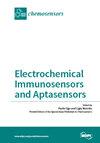Hydrothermally Synthesized Cerium Phosphate with Functionalized Carbon Nanofiber Nanocomposite for Enhanced Electrochemical Detection of Hypoxanthine
IF 3.7
3区 工程技术
Q2 CHEMISTRY, ANALYTICAL
引用次数: 0
Abstract
This work presents the detection of hypoxanthine (HXA), a purine derivative that is similar to nucleic acids who overconsumption can cause health issues, by using hydrothermally synthesized cerium phosphate (CePO4) followed by a sonochemical approach for CePO4 decorated with a functionalized carbon nanofiber (CePO4@f-CNF) nanocomposite. The formation of the nanocomposite was confirmed with X-ray powder diffraction (XRD), scanning electron microscopy (SEM), and energy-dispersive spectroscopy (EDS). A CePO4@f-CNF nanocomposite is used to modify a glassy carbon electrode (GCE) to analyze the electrochemical detection of HXA. Cyclic voltammetry (CV), Electrochemical impedance spectroscopy (EIS), and Differential pulse voltammetry (DPV) were used to examine the electrochemical properties of the composite. As a result, the modified electrode exhibits a larger active surface area (A = 1.39 cm2), a low limit of detection (LOD) at 0.23 µM, a wide linear range (2.05–629 µM), and significant sensitivity. Therefore, the CePO4@f-CNF nanocomposite was used to study the real-time detection in chicken and fish samples, and it depicted significant results.水热合成的磷酸铈与功能化纳米碳纤维纳米复合材料用于增强次黄嘌呤的电化学检测
次黄嘌呤(HXA)是一种嘌呤衍生物,与核酸相似,过量摄入会导致健康问题。本研究利用水热法合成磷酸铈(CePO4),然后采用超声化学方法将CePO4与功能化碳纳米纤维(CePO4@f-CNF)纳米复合材料装饰在一起,对次黄嘌呤(HXA)进行检测。X 射线粉末衍射(XRD)、扫描电子显微镜(SEM)和能量色散光谱(EDS)证实了纳米复合材料的形成。CePO4@f-CNF 纳米复合材料用于改性玻璃碳电极(GCE),以分析 HXA 的电化学检测。循环伏安法(CV)、电化学阻抗谱法(EIS)和差分脉冲伏安法(DPV)被用来检测该复合材料的电化学特性。结果表明,改性电极的活性表面积更大(A = 1.39 cm2),检出限(LOD)低至 0.23 µM,线性范围宽(2.05-629 µM),灵敏度高。因此,CePO4@f-CNF 纳米复合材料被用于研究鸡肉和鱼肉样品中的实时检测,并取得了显著效果。
本文章由计算机程序翻译,如有差异,请以英文原文为准。
求助全文
约1分钟内获得全文
求助全文
来源期刊

Chemosensors
Chemistry-Analytical Chemistry
CiteScore
5.00
自引率
9.50%
发文量
450
审稿时长
11 weeks
期刊介绍:
Chemosensors (ISSN 2227-9040; CODEN: CHEMO9) is an international, scientific, open access journal on the science and technology of chemical sensors published quarterly online by MDPI.
 求助内容:
求助内容: 应助结果提醒方式:
应助结果提醒方式:


